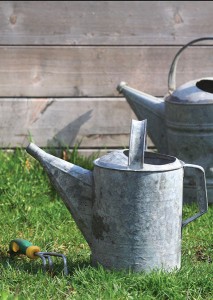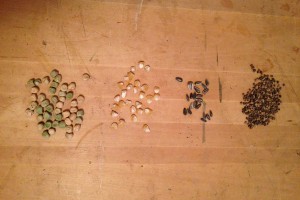Gardening is more than just tossing seed packets into a grocery cart or choosing seeds from catalogs based on the photos. It’s more than digging up some dirt and sprinkling seeds every few inches. Gardening is a hobby, and it’s a time-consuming one that spans the seasons and can be affected by the weather, pests and diseases.
If you want the best chance at a successful garden, you’ll need to consider a number of factors. From hardiness zones and soil types to sunlight amounts and plant needs, basic garden knowledge and management are vital to success.
Consider the following 10 tips before you start your garden this year:
1. Do your research
Before you purchase seeds, know which hardiness zone you live in. Hardiness zones are determined by the average extreme minimum temperature recorded. Ohio has three hardiness zones: 5b, 6a and 6b. Portions of some counties have all three hardiness zones. You can view a larger hardiness zone map on the USDA website.
You should also know what kind of soil you’ll be working with. Test your soil before you plant, then make any amendments and add organic matter if needed. Also, keep in mind that garden soil should drain well.
Another factor to consider is the amount of sunlight your garden will receive each day. Sunlight affects plant growth and performance, so you want to figure out the amount of sunlight potential garden locations receive each day. Some plants need full sun to thrive, while others do well in partial shade/sun.
2. Know planting options

Raised beds are an option for those with physical limitations, or for those who wish to conserve water.
3. Start small
Your garden doesn’t have to be large to be considered a success. Purdue University Extension recommends a 100-square-foot plot for your first garden.
Focus on a handful of plants to grow the first year to hone your skills and give proper care to each plant. Next year, build on those skills by adding additional plants or different varieties to your plot.
4. Grow what you’ll use
There isn’t much sense in growing vegetables you don’t like or herbs you won’t use. Before you plant, decide if you want to can vegetables or freeze herbs at the end of the season. Choose plants that won’t go to waste at harvest time.
5. Choose quality seeds
University of Oregon Extension recommends purchasing seeds that have 65 to 80 percent germination rates. Following planting recommendations on seed packets, like how many seeds to plant, at what depth to plant and the ideal amount of sunlight for each plant will increase chances of successful growing.
Check your local greenhouses for seeds and seedlings, suggests Penn State Extension. The plants offered locally should be known for growing well in your area.
6. Have the proper tools
You’ll need some basic tools to garden. Make sure you have the following: hand trowel, hoe, shovel, spade, spading fork, hand weeder, hand cultivator, watering can, hose, bucket, floral shears and pruners.
Having the correct tools will make planting, weeding and harvesting much easier to complete.
7. Practice pest and weed control
Birds, insects, groundhogs, deer, rabbits and just about any backyard animal you can think of can get in your garden and affect the growth or your plants or eat your harvest before you get to it. Using repellents — including natural ones you can make at home — is one method of controlling these pests.
Before you apply insect spray on every moving creature you see on your seedlings, find out which bugs are OK to see in your garden and which ones shouldn’t be there.
Blackbirds and crows can be destructive to gardens. Strategies like placing shiny objects around your garden or covering your plants with netting can deter birds.
Weeds will seem like they pop up out of nowhere overnight. Be diligent with weeding. If you let weeds go, it will be overwhelming to remove them all at once. Weeds choke out the plants you’re growing. They take nutrients from the soil that your plants need to thrive.
8. Water

You can tell when your plants need water: their leaves will be wilted or have brown tips; growth will be slow; and production will be less than usual.
Farm and Dairy online columnist Ivory Harlow offers watering advice, such as paying attention to your soil type and weather patterns.
9. Track your progress
Keep a journal of your garden records. Include the following:
- Garden/landscape design: Draw (to scale) what your garden looks like
- Preparations and treatments to garden soil prior to planting
- Pest management strategies
- The seeds you plant; when and where you plant them
- Fertilizer and compost application
- Watering schedule
- Simple weather details (temperature, conditions, precipitation amounts) each day
- Plant growth
- Harvest dates and quantities
You can also include expenses like seeds, fertilizer and tools in your records.
There isn’t a right or wrong way to plan your garden. Online columnist Ivory Harlow gives the details on using paper, computer and templates to plan your garden. Choose the method that best suits your record-keeping style.
10. Be patient

Vegetables for beginners to grow in zones 5-6
If you live in zone 5 or 6, which covers most of Ohio, here are 16 plants that typically grow well and give new gardeners ample practice, based on suggestions from Ohio State University Extension:
- Kale
- Leaf lettuce
- Spinach
- Swiss chard
- Squash
- Peas
- Lima beans
- Snap beans
- Carrots
- Beets
- Parsnips
- Turnips
- Radishes
- Salsify
- Cabbage
- Tomatoes
Have any questions about gardening? Ask us in the comments section.
Farm and Dairy’s gardening resources:
Ordering and starting seeds
- Tips for ordering from seed catalogs
- 6 ideas for gardening with kids
- Starting seeds indoors: What you need to know
- Which seeds should I start indoors?
Planning your garden and keeping records
- 3 ways to plan your garden: paper, virtual or template
- Recordkeeping for the garden
- Gardening resolutions for the new year
Pest management
- How to protect your garden from birds
- How to manage insects in the garden
- How to choose repellents to control garden pests
- How to keep pests out of your garden
Plant, soil and tool care
- Water your vegetable garden for optimal performance
- Sunlight requirements for growing vegetables
- The many faces of mulch: How to choose the best for your lawn and garden
- How to test your garden’s soil
- How to prepare garden soil for spring planting
- How to prepare tools for spring gardening
Garden types
- How should I arrange the plants in my garden? A guide to companion planting
- How to build a square foot garden
- How to grow a container garden: 10 tips
- How to start a container garden














